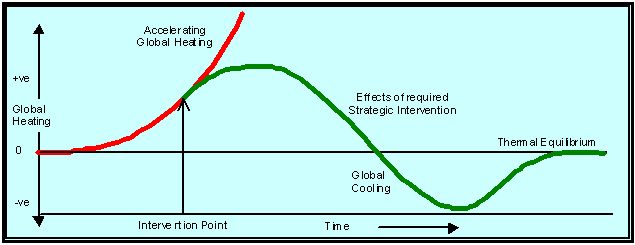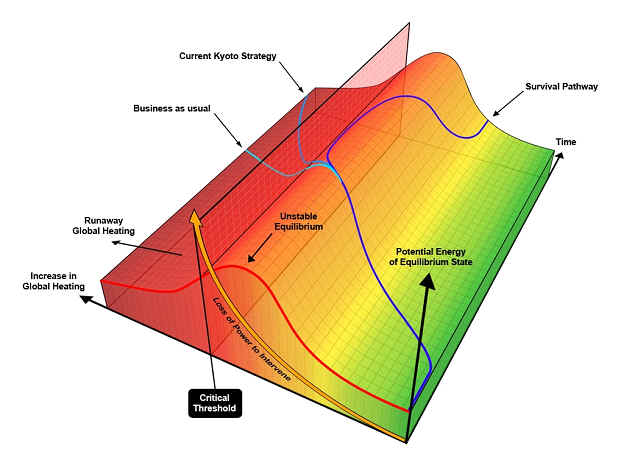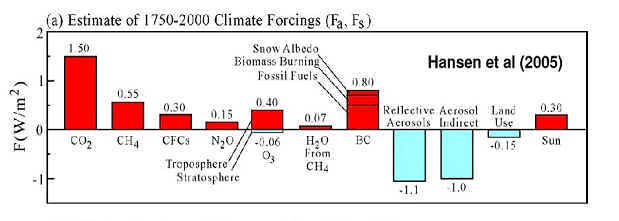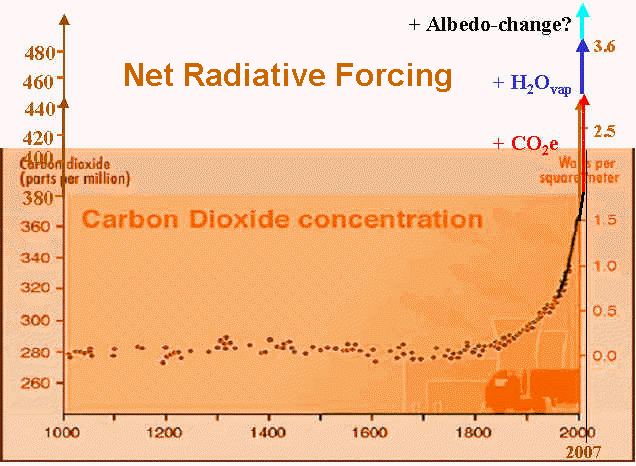 |
 |
| Adaptation to unmitigated climate change is now recognised to be physically impossible and financially unmanageable. That is the stark message to the world from the conservative bedrock of the Fourth Assessment Report of the Intergovernmental Panel on Climate Change. Policy-Makers are now entering a new chapter in human history which calls for leadership at a previously unprecedented level of courage and competence. |
Submitted to the Environment, Food and Rural Affairs Committe of the UK Parliament, June 2007AbstractPositive feedbacks are now accelerating global warming and threatening to send it out of control. Stabilisation of the Climate in this complex system with long time delays now requires a strategic intervention that turns off the heat before it is too late (i.e. reduces "radiative forcing" to zero). This paper highlights the scale of the task ahead. [2007]* * * * * * * * * * The Task we FaceThe fundamental objective now faced is the stabilisation of global climate within a temperature range that minimises dangerous climate change and avoids catastrophic climate change. All policies, regulations and initiatives must be assessed against that yardstick. The task is not achieved by stabilising CO2 emissions, nor by stabilising CO2 concentrations, necessary first steps though these initiatives are. The effect of the amplifying feedback system, which accelerates the pace of climate change, necessitates a more radical approach based on reducing "radiative forcing" to zero. The most powerful feedbacks are independent of the carbon cycle. They are driven by rising temperature, and, once activated, are almost impossible to control.With this new understanding of the dynamics of climate change, we can clarify the intervention strategy required if catastrophic global warming is to be prevented, and climate stabilisation is to be achieved. 
The Dimension of TimeIt takes a long time and an enormous amount of heat to raise the temperature of something as massive as the whole earth. Air and land warm fastest. The oceans absorb an immense amount of energy for only a small rise in temperature, a process that is damped even further by evaporation and ice-melt. The result is "thermal inertia". In other words while "global heating" keeps pace with the greenhouse effect and all the associated feedbacks, global warming does not! (Global heating is the energy input usually referred to as "radiative forcing", the difference in watts per square metre between energy received from the sun and energy radiated out again into space.) There is a time-delay between cause and effect of more than half a century. The more intense the radiative forcing, the longer the time-delay before its full effects are seen.So far we have had a rise of just over 0.7oC in average global temperature. All the climate impacts currently observed are a response to this small change. They represent the effects of greenhouse gas concentrations that were reached in about 1960. Meanwhile the rate of global heating (radiative forcing) has soared and is accelerating faster and faster. Even if we stabilised greenhouse gas concentrations today, we would still face at least a quadrupling of the temperature change already experienced. Feedbacks would make it worse still. If storm energy doubled between 1970 and the year 2000 on an increase in temperature of only 0.7oC, then what will the storm energy become when we quadruple that temperature rise? The cause of such a rise in temperature is already in the system. Dangerous climate change is now unavoidable. That is why basing strategic policy on observed effects of global warming is totally inadequate. It ignores the time-delays. In climate systems, by the time dangerous change is observable, the point of intervention to prevent it is already well passed. Political systems that only respond after the event ("catastrophe first" decision-making) condemn the world to uncontrollable and catastrophic climate change. From Observation of Symptoms to Understanding SystemsCompetent policy-makers are highly skilled in scanning information, recognising patterns, identifying critical observations, and then mobilising reactions to respond to presenting symptoms. The long time-delays and complex dynamics involved in climate systems render this approach not only totally inadequate, but dysfunctionally disastrous as a ground on which to base strategic policy.If we wait for observation to confirm prediction before taking action, we lose the window of opportunity to make a difference to the system. The timing and scale of intervention has to relate to predicted behaviour some 50 - 300 years down track, because it takes that long for the intervention to change the system. The next half-century of system behaviour is already pretty-much inevitable. The causes of that behaviour are already in the pipeline. When dealing with a complex adaptive system with long time-delays, we have to move beyond the comfort-zone of observation/reaction, beyond the response of simple cause-and-effect mentality. Our task is to understand the long-term dynamics of the system and to generate present strategy in the light of that understanding. To that end, detailed observation of current climate change serves not as a ground for policy formulation, but as a test-bed for checking out the accuracy of our long-term models, which in turn form the only available ground for strategic decision-making. A "Landscape Presentation" of climate dynamics The tipping point, or watershed, is represented by the ridge stretching from left to right. Near to the front face is the green valley area of historically stable equilibrium during the glacial/interglacial period. The surface rises from the valley through the inflection line, where the positive feedback loops begin to influence the system. It then climbs on up to the unstable equilibrium at the summit of the ridge where the positive and negative feedback processes just cancel each other out. Over the hill, where we now are, the positive feedback loops are dominant and accelerate runaway global heating and the resultant climate change. The wall marking the critical threshold rises through the down-slope, beyond the peak of the unstable equilibrium. The window of opportunity within which human intervention (by reduction in GHG emissions, increased cloud albedo, etc.) is able to contain the process of global heating and return the system to equilibrium, lies uphill from the critical threshold. It is not yet clear how close to that threshold we are in reality, or whether in fact it has already been passed. Inactivity is not neutral. Every passing year reduces even further the window of opportunity within which it is still possible to avoid the chain-reaction of uncontrollable runaway climate change. Loss of power to intervene in the system becomes absolute as the wall is approached. The closer we come to the critical threshold, the more massive and costly the required intervention becomes. Current strategies assume no limit to the time-scale within which it is still possible to intervene effectively. They also deny any degrade in the ability of emissions-reduction to control the rate of global heating however high it becomes. In so doing they gravely underestimate the power of positive feedback. These are false assumptions that are placing the future of our civilisation in extreme danger. The New Role of ScienceIn this situation, scientific research acts as a reality check on policy formulation. It sets the parameters, and defines the limits and constraints within which the range of viable options must be kept if catastrophic climate change is to be avoided. The stabilisation of global climate is not an option to be bargained with in relation to demands from those whose vested interests are most at risk. It is an imperative of survival which takes precedence over all other considerations. It will be important that this role of science is effectively represented in the membership and procedures of the proposed Climate Change Committee.Climate Stabilisation: Quantification of the TaskThe acceleration of radiative forcing from the release of anthropogenic greenhouse gases over the last one and a half centuries is illustrated below. Methane concentrations have stabilised as electricity generation shifted from coal to gas during the 1990s, as methane release from oil fields was reduced and as methane output from landfill was brought under greater control. Today gas supplies are more limited and there is a return to coal as a source of electricity generation. Methane release from store in both tundra permafrost and sea-bed clathrates has been initiated, though the effects are partially offset by reduction in methane output from drying tropical wetlands. We can expect the methane concentration to resume an upward trend in the near future. Nitrogen oxides constitute a small but rising contribution to radiative forcing. Their emission flows from the increasing use of artificial fertilisers on a global scale. CFCs stabilised in concentration following the Montreal Protocol in the early 1990s. Further emission is now minimal, but their long life in the atmosphere means that their contribution to radiative forcing will only slowly degrade. Anthropogenic emissions of carbon dioxide constitute the main factor in the acceleration of radiative forcing. By the year 2000 atmospheric concentration of CO2 contributed some 1.5 watts per square meter to global heating in comparison to pre-industrial equilibrium. A more detailed breakdown of the constituents at the turn of the century has been provided by James Hansen and his team at NASA (GISS).  In terms of gaseous contribution to radiative forcing, Hansen's work correlates with the previous diagram, but adds the effects of ozone and stratospheric water vapour (from the breakdown of methane). He brings in the effects of black carbon, both as heat-absorbing aerosols and as albedo-reducing deposit on the highly reflective snow and ice surfaces. Then he treats the cooling effect of reflecting aerosol particulates, and their indirect effect via cloud formation. He concludes with the small cooling from change in land use and the small heating from change in solar radiant energy. The last five categories sum to a net cooling of approximately 1 watt per square meter. Contribution to radiative forcing from increased troposphere levels of water vapour responding to increases in temperature at the air-ocean interface has not been included. He also omits the net change in albedo (also a temperature-driven feedback) stemming from decrease in ice and snow areas, and shorter duration of snow cover. Taking all these factors into account and updating to 2007 levels, concentration of atmospheric CO2 is currently at 383 ppm. Effects of CO2 (equivalent) greenhouse gases including methane, nitrogen oxides, CFCs and ozone, take this figure up to some 450 ppm. The radiative forcing from increased tropospheric water vapour-concentration (confirmed in IPCC 4AR: WG1) at the rate of 1 watt per square meter per degree C rise in average global temperature, yields an extra 0.7 Wm-2. The increased radiative forcing from albedo change is estimated at a further 0.3 Wm-2. The diagram indicates a current net radiative forcing from all agents of 3.0 Wm-2. This is made up from 4 Wm-2 driven by all greenhouse effects plus contribution from albedo, reduced by 1 Wm-2 as the sum of contributions from black carbon, aerosols, land use and change in solar radiation. The heat engine driving climate change is now running at 1,528,800 billion watts (or about 1% of received solar energy). And it is rising steadily!  Current Radiative Forcing (Global Heating) Intervention StrategyIntervention Point with 2007 ValuesReduction in radiative forcing of 1 Wm-2 can be achieved by a lowering of CO2e concentration by some 57ppm. Climate stabilisation at 2007 values requires a reduction in radiative forcing of 3 Wm-2, in other words, the cessation of all emissions and a further reduction in atmospheric concentration of CO2e by 170 ppm. to its pre-industrial value of 280 ppm. This negative-carbon economy would only lead to climate stabilisation if all feedback mechanisms were held at zero for the duration of the reduction period.In reality, temperature would continue to climb until zero forcing was achieved. Temperature driven feedbacks would therefore still be active, with increased forcing from rising water vapour concentration, methane release, albedo reduction, non-anthropogenic release of CO2 from net biomass burning, and bacterial activity. Absorption sinks would show continuing degrade during this period. The task of climate stabilisation would therefore require a significantly more stringent reduction in CO2e concentration, depending on the time-scale and the strength of feedback dynamics involved. In addition, the required negative carbon economy would massively reduce emissions of black carbon and particulate aerosols. This removal of the net "global dimming" effect would add a further 1 Wm-2 to radiative forcing during the period of intervention, demanding even deeper levels of carbon sequestration. In ConclusionIf international negotiations were dragged out and "business as usual" behaviours continued to 2030, the task of climate stabilisation would become even more difficult.The rate of radiative forcing is accelerating. At the moment the problem is worsening by some 25% per decade, and that rate is rising. Our ability to re-stabilise global climate by drastic reduction in the concentration of atmospheric CO2e is declining rapidly and will soon be completely overwhelmed by the power of the positive feedback system. Failure to act decisively within the remaining window of opportunity will precipitate a mass extinction event on an unprecedented scale. Finally it must be recognised that climate stabilisation would still generate equilibrium temperatures leading to catastrophic impacts of climate change. Climate stabilisation at equilibrium temperature close to the maximum of the Holocene inter-glacial warm period (so minimising catastrophic impacts) would require even more stringent intervention measures. |